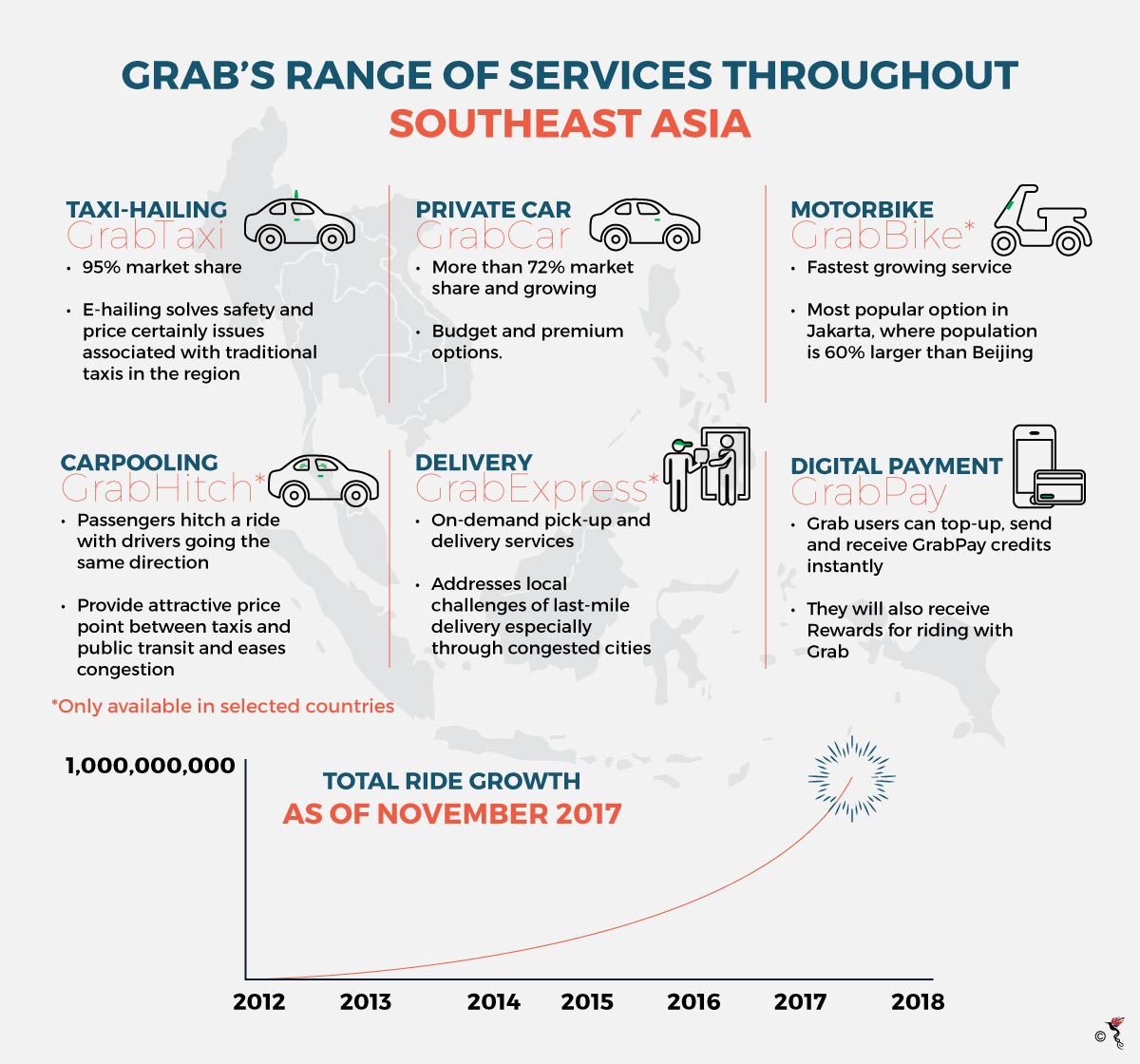Grab first started out as MyTeksi in Malaysia. Its founder Anthony Tan started the business to improve on the poor state of the existing taxi system here, and to provide better security for women, whenever they used public transport.
Grab’s initial strategy to use technology to overcome these issues has since proven itself across still-developing Southeast Asia. As of 2017 the company holds 72% of market share in private vehicle hailing across a total of 156 cities in the region. According to a joint report by Google and Temasek Holdings in 2016, Grab expects to hit a valuation of US$13.1 billion by 2025, up from US$2.5 billion in 2015.
Localised approach
Grab’s key to rapid expansion in Southeast Asia is due to its localised approach. For example, it has designed its mobile app in such a way as to fit individual markets. Elements like the app language and local payment platforms are adapted according to local needs. Grab also capitalises on local transport modes, for example employing ‘trikes’ as part of its transportation fleet in the Philippines, where it started operations in 2013. This however is the sort of approach that has helped it gain reach outside urban areas, where mobility is the most challenging.
Having expanded into Myanmar in April last year, Grab aims to push its corporate travelling services and to expand digital payments. An investment of US$100 million will be spread over the next three years to make this a reality.
Grab’s partnerships have resulted in additional business opportunities for its local partners. Partnerships with local entities like e-commerce platform MatahariMall in Indonesia for delivery services and NTUC Fair Price supermarkets in Singapore to offer subscription services helps Grab to reach a more diversified customer base. The NTUC Fair Price deal, for instance, ensures that subscribers will not only get rebates on their Grab rides, but also enjoy discounts on NTUC Fair Price products.

Sources: Grab & TechCrunch
It is by leveraging off these partnerships Grab can focus on what it does best in providing rides while at the same time having a presence in different market segments.
Grab has attracted 2.1 million drivers to its platform, some of whom are traditional taxi drivers who have been drawn to its attractive fare scheme.
It also has taken a new approach upon entering the Cambodian market. In partnership with local digital payments provider Wing Money, Grab launched digital payments there alongside its ride-hailing services. All this was done under its digital payments arm, GrabPay.
As part of its aggressive push into digital payments, GrabPay has appointed former Visa country director for Brunei and Singapore, Ooi Huey Tyng as managing director for GrabPay Malaysia, Singapore and Philippines.
“Huey Tyng brings deep leadership expertise from some of the region’s premier banks and payments providers. Her experience with our current and potential payments partners will be invaluable as GrabPay moves into its next phase of growth. Millions of people in Singapore, Malaysia and the Philippines are still heavily dependent on cash. Huey Tyng’s skills in forging business partnerships across each country will enable us to bring more merchants and consumers into the cashless future faster,” said Jason Thompson, managing director of GrabPay Southeast Asia.
Data from ride-hailing could also be used to help city planning in the future. Grab is already collaborating with Myanmar mapping provider Here to compile GPS data gleaned from Grab Driver apps to form a mapping database. The gathering of GPS data thus is also done with the blessing of the Cambodia’s transport ministry, who feels that this would help to develop the local infrastructure.
Grab’s services offer more efficient transport networks for cities where they are present. This can be seen with Singapore’s SMRT collaboration with Grab to form the largest private car-hire and taxi fleet in Singapore.
With a large private fleet of private cars, partnerships across various markets in Southeast Asia, and a big data bank, Grab might soon play a significant role in shaping ASEAN’s future. Until then, it will keep on piling up footprints.
Recommended stories:
